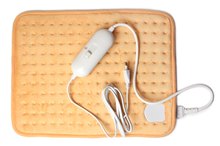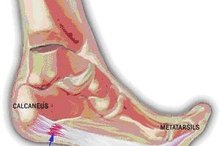What Are the Treatments for Tendinitis of the Foot?
Tendonitis in the foot is often related to inflammation of the plantar fascia, the tendon located on the bottom of the foot. Tendonitis is normally caused by overuse and the repetitive motions of certain exercises, such as running, jumping or sprinting. This can cause tiny tears in the tendon which can become inflamed if it is not allowed to heal properly. Symptoms of tendonitis include stiffness or pain in the foot upon getting out of bed in the morning or when first starting an exercise. This pain can decrease during activity once the tendon is warmed up, but it usually comes back afterward. If caught early, treatment of tendonitis in the foot can be relatively simple.
If you are experiencing serious medical symptoms, seek emergency treatment immediately.
Rest
Recognize the activity that is causing the foot pain and reduce or eliminate it until the pain is gone. Avoid running or playing through the pain because this is likely to make it worse. Rest is the best way to let the foot heal. You can still remain active, just choose exercises that do not put stress on the foot. For example, if you run, try something non-impact like swimming instead.
- Recognize the activity that is causing the foot pain and reduce or eliminate it until the pain is gone.
- You can still remain active, just choose exercises that do not put stress on the foot.
Ice
Exercises for Tendonitis of the Foot
Learn More
Cold helps reduce the pain and inflammation. Wrap a thin towel around a bag of frozen vegetables or ice pack and apply to the heel and bottom of the foot three to four times a day for 10 to 15 minutes at a time. Do not put the cold pack directly on the skin because this can cause frostbite. You can also do an ice massage directly to the foot and heel.
- Cold helps reduce the pain and inflammation.
- You can also do an ice massage directly to the foot and heel.
Stretch
Once the pain is reduced or gone, gently stretch the foot, ankle and calf three to four times a day. Focus on stretching the Achilles tendon and plantar fascia. Use stretches such as calf wall stretches and heel raises on a step to stretch your plantar fascia. Tight muscles and tendons can trigger inflammation and put more strain on the foot.
- Once the pain is reduced or gone, gently stretch the foot, ankle and calf three to four times a day.
- Use stretches such as calf wall stretches and heel raises on a step to stretch your plantar fascia.
Anti-Inflammatories
Ankle Tendinitis Symptoms and Treatment
Learn More
If your doctor agrees, take an NSAID, a non-steroid anti-inflammatory, such as ibuprofen, to help reduce swelling if the plantar fascia is inflamed.
Massage
Sports massage therapists can be helpful in relieving the pain caused by tendonitis and inflammation. They can identify which muscles, ligaments and tendons are tight and massage and loosen those to relieve the pressure. They can also break up adhesions and scar tissue that can cause tightness.
Medical Treatments
Physical therapy is often used to treat the source of the problem. Stretching, massage and ultra-sound therapy can relieve the inflammation, increase blood flow and stimulate healing of the tears in the tendon. Other medical treatments can include cortisone shots, shock wave therapy or surgery. All of these options are reserved for more serious cases of foot pain, if none of the above treatments work first.
- Physical therapy is often used to treat the source of the problem.
- All of these options are reserved for more serious cases of foot pain, if none of the above treatments work first.
Related Articles
References
- Health Scout
- Mueller S, Carlsohn A, Mueller J, Baur H, Mayer F. Influence of obesity on foot loading characteristics in gait for children aged 1 to 12 years. PLoS ONE. 2016;11(2):e0149924. doi:10.1371/journal.pone.0149924
- American Academy of Orthopaedic Surgeons, OrthoInfo. Plantar fasciitis and bone spurs.
- Lim AT, How CH, Tan B. Management of plantar fasciitis in the outpatient setting. Singapore Med J. 2016;57(4):168-70. doi:10.11622/smedj.2016069
- Ross MH, Smith MD, Mellor R, Vicenzino B. Exercise for posterior tibial tendon dysfunction: a systematic review of randomised clinical trials and clinical guidelines. BMJ Open Sport Exerc Med. 2018;4(1):e000430. doi:10.1136/ bmjsem-2018-000430
- American Academy of Orthopaedic Surgeons, OrthoInfo. Turf toe. Reviewed June, 2019.
- National Library of Medicine, MedlinePlus. Tarsal tunnel syndrome. Reviewed March 11, 2019.
- Cleveland Clinic. Heal pain: common causes, symptoms, and treatments. Reviewed December 13, 2017.
Writer Bio
Deborah Dunham is a freelance writer with 10 years of experience writing for the health and fitness industry. Her expertise and writing focuses on running, marathons, training, nutrition and healthy living. She is an ACE-certified personal trainer and certified RRCA running coach.







